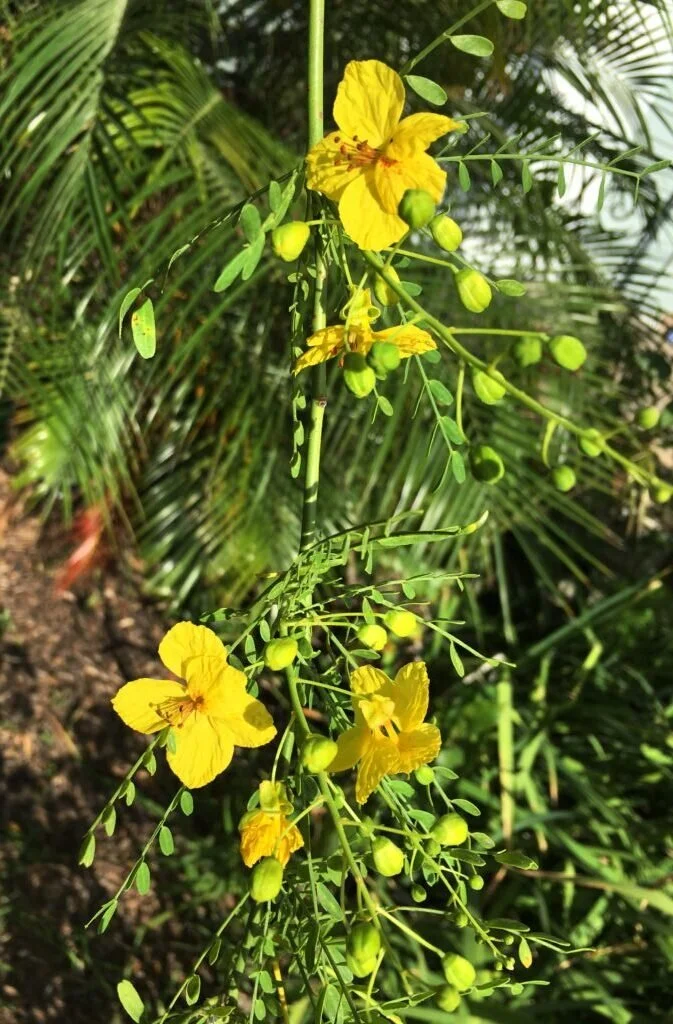Retama
Retamas Blossom after Dry Period when Rainy
By Margaret Canavan
Editor’s note: Hurricane Ike caused the loss of 40,000 trees on Galveston Island. The Galveston Island Tree Conservancy was formed to address that loss and has replaced over 17,000 through grant-funded plantings and giveaways.
Recent rains have been a real gift to our trees. Our wet winter was followed by a relatively dry spring, so June rains have provided a boost that will help them thrive during our scorching summer and boom-or-bust rainfall season.
Rainy events following a dry period causes many flowering plants to rebloom. A tree that responds in this way is the Retama (Parkinsonia auculeata). In nature, Retama is a desert dweller, native from Texas south to northern South America and west to Arizona and knows how to take advantage of rainfall. It blooms primarily in spring, but rainy periods may cause intermittent flowering through autumn. Showy clusters of small bright yellow flowers resemble pea blossoms.
A particularly striking specimen on Postoffice Street at the corner of 15th Street. There are several others around town, which many were installed during NeighborWoods plantings.
Retama is a rapidly-growing mostly evergreen tree that can reach 15 to 20 feet in height. Its small leaves and multi-trunked growth habit create a graceful and lacy canopy that casts dappled shade. This desert survivor is a drought, heat and salt-tolerant and requires full sun and good drainage to thrive. It adapts to poor soils and a variety of weather conditions. Galveston is not a desert, but it can seem that way if summer rain eludes us.
One of Retama’s common names is Paloverde, which is Spanish for “green pole” or “green stick,” so named because the trunks and branches are green. The green trunk and branches perform photosynthesis even when leaves are dropped due to drought or extreme cold.
You may recall from science class that photosynthesis is the process by which green plants and some other organisms use sunlight to create food from carbon dioxide and water and generate oxygen as a byproduct. This is a boon for these trees when leafless during times of drought or extreme winter cold.
Retama is also known as “Jerusalem thorn,” which suggests a certain prickliness. Indeed the native version of this tree has some impressive thorns. A modern thornless hybrid, “Desert Museum,” is available in the nursery trade, but does tend to sell out quickly during planting season.
Bees and other pollinators adore this plant, and during blooming the tree will be swarming with them. Blossoms are followed by seed pods, which are a food source for small animals and birds. The plant’s seeds have been used as a food source by some native people, and the wood is used for creating food implements.
Retama is popular as a landscape plant for its rapid growth, floral display and its open, airy canopy of bright green leaves and unusual green trunk. It can be a good choice for the right spot given Galveston’s unpredictable rainfall. Trees are available in the nursery trade but can be propagated from seeds if you are patient. This true desert plant requires a minimum in the way of cultivation, given the right growing conditions.
———
“Tree Stories” is an ongoing series of articles about island trees, tree care and tree issues. If you have or know of a special tree on Galveston Island that should be highlighted, email treesforgalveston@gmail.com. Margaret Canavan is a Galveston resident, a Galveston County Master Gardener, and a member of the Galveston Island Tree Conservancy Board.


